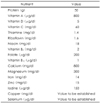1. Report of a Joint FAO/WHO Expert Consultation on Recommended Allowances of Nutrients for Food Labeling Purposes. 1988. In : Recommended Nutrient Reference values for Food Labeling Purposes; 12-16 September; Helsinki, Finland. Finland: FAO/WHO/Ministry of Trade and Industry.
2. Department of HSS, FDA. Food Labelling: Reference Daily Intakes and Daily Reference Values-Final rule. Federal Register. 1993. 01. 06. 58(3):2206–2228.
3. Institute of Medicine. Dietary Reference Intakes: Guiding Principles for Nutrition Labeling and Fortification. 2004. Washington (DC): National Academy Press.
4. Discussion paper on the proposals for additional or revised nutrient reference values for food labelling purposes. CODEX, CCNFSDU 28th session. 2006. 10. 06/28/8; Chiang Mai, Thailand. Agenda Item 8, CX/NFSDU.
5. Agenda Item 8 (b), Nutrient reference values for labelling purposes. 1998. 07. In : CX/NFSDU; 98/9; CCNFSDU.
6. Scientific Committee on Food (SCF)-Infant formulae and follow-on formulae SCF/CS/NUT/IF/65 Final. 2003. 05. European Commission (EC).
7. Summary of inputs received from WG members on the revision and addition of NRVs for food labelling purposes during 2004 to 2005, with special focus on the criteria for establishing NRVs. CODEX, CCNFSDU 28th session. 2006. 11. CRD 12, Agenda Item 8.
8. Dietary Reference Intakes for Koreans. 2005. Seoul: The Korean Nutiriton Society.
9. Dietary Reference Jntake for Japanese. 2005. Japan: Ministry of Health labour and Welfare;The first publication.
10. Institute of Medicine. Dietary reference intakes for calcium, phosphorus, magnesium, vitamin D, and fluoride. 1997. Washington, DC: National Academy Press.
11. Institute of Medicine. Dietary reference intakes for thiamin, riboflavin, niacin, vitamin B6, folate, vitamin B12, pantothenic acid, biotin, and choline. 1998. Washington, DC: National Academy Press.
12. Institute of Medicine. Dietary reference intakes for vitamin A, Ar, Bo, Cr, Cu, I, Fe, Mn, Mo, Ni, Si, Va and Zn. 2001. Washington, DC: National Academy Press.
13. Institute of Medicine. Dietary reference intakes for vitamin C, vitamin E, selenium, and carotenoids. 2000. Washington, DC: National Academy Press.
14. Institute of Medicine. Dietary reference intakes for water, potassium, sodium, chloride, and sulfate (The US/Canada), Panel on Dietary Reference Intakes for Electrolytes and Water. 2004. Washington, DC: National Academy Press.
15. National Health and Medical Research Council. . Nutrient Reference Values for Australia and New Zealand including Recommended Dietary Intakes. 2004. New Zealand: Commonwealth Department of Health and Ageing, Australia, Ministry of Health.
16. Food and Nutrition Research Institute, Department of Science and Technology. Recommended Energy and Nutrient Intakes. 2002. The Phillippines:
17. European Commission (EC). Nutrient and energy intakes for the European Community. Reports of the Scientific Committee for Food, Thirsty-First Series. Opinion adopted by the Scientific Committee on Food on 12 December 1992. European Commission: Luxembourg;
http://europa.eu.int/comm/food/fs/sc/scf/out89.pdf.
18. WHO/FAO (World Health Organization and Food and Agriculture Organization of the United Nations). Report of a Joint FAO/WHO Expert Consultation. Human Vitamin and Mineral Requirements. 2002. Bangkok, Thailand: FAO Rome.
19. Recommended Dietary Allowances: Harmonization in Southeast Asia. 2005. Singapore: International Life Sciences Institute (ILSI) Southeast Asia Series.
20. German Nutrition Society. Reference Values for Nutrient Intake. 2002. 1st ed. Bonn, Germany:
22. European Commission (EC). Scientific Committee on Food (SCF). The processed cereal-based foods and baby foods for infants and young children. Directive 2006/125/EC.
24. Report of the electronic working group on the revision and addition of NRV's for Food Labeling purposes. Agenda Item 4. CODEX, CCNFSDU 26th session. 2004. 11. Bone, Germany. CX/NFSDU 04/04/4Add.1.
25. European Commission (EC). SCF/CS/NUT/GEN/18 Final 6. Opinion of the Scientific Committee on Food on the revision of reference values fro nutrition labelling. 2003. 03.
26. Institute of Medicine. Dietary Reference Intakes: Guiding principles for Nutrition Labeling and Fortification. 2004. Washington DC: The National Academies Press.
27. WHO/FAO (World Health Organization and Food and Agriculture Organization of the United Nations). WHO Technical Report Series No.916. Diet, Nutrition and the Prevention of Chronic Diseases. The Report of Joint WHO/FAO Expert Consultation. 2003. Geneva: World Health Organization;
http://www.fao.org/docrep/004/y2809e/y2809e00.htmhttp://www.fao.org/docrep/004/y2809e/y2809e00.htm.











 PDF
PDF ePub
ePub Citation
Citation Print
Print



 XML Download
XML Download